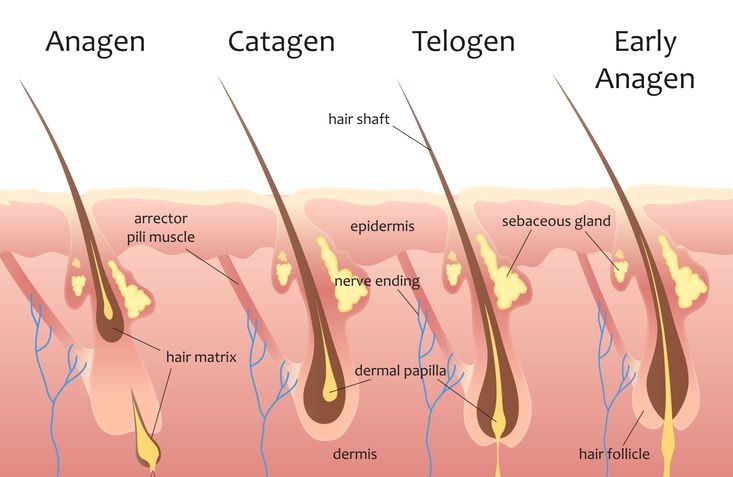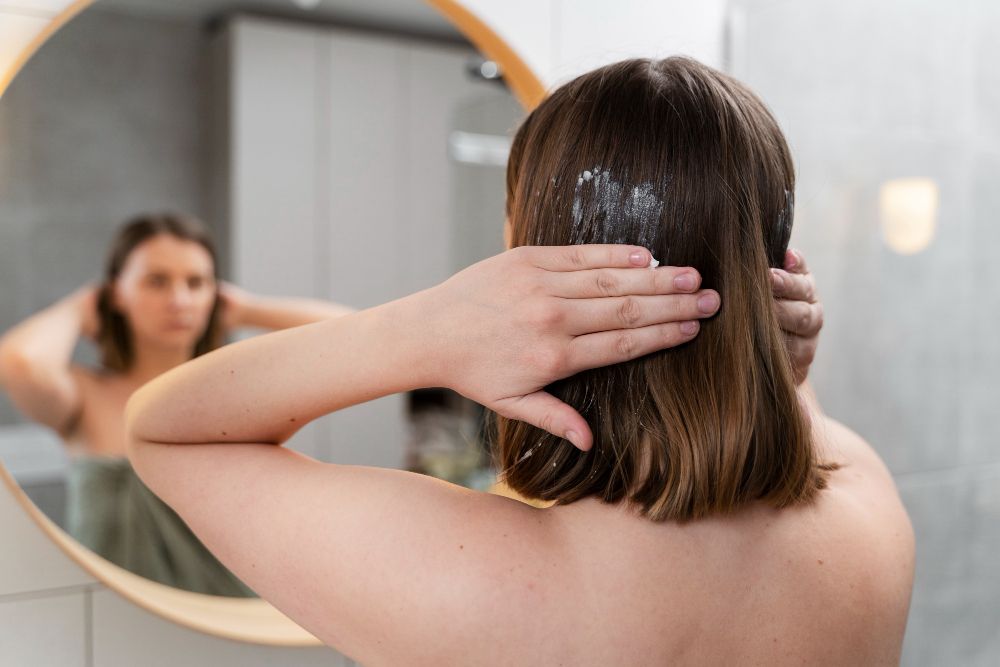- Home
- Trend
- Weight Loss Strategies
- Acne Tips
- Hair Health Information
- Blemish Removal Tips
- Acne Scar Removal Tips
- Muscle Building Techniques
- Intimate Care Tips
- Postpartum Intimate Care
- Eye Bags Wiki
- Tips for Face Slimming
- Secret of Permanent Hair Removal
- Breast Enlargement Tips
- Cure to Snoring
- Marionette Lines
- Skin-Tightening Secrets
Your hairstyle can affect how attractive you look. But if your hair is so thin that the scalp is visible, can you still look your best? The hair growth cycle plays a key role in how much hair you have—understanding it is worthwhile. The good news? It’s not complicated—there are just four phases: the growth phase, regression phase, resting phase, and shedding phase. Your hair growth rate is closely tied to these cycles. Many people feel their hair grows too slowly, but there’s a reason for that. Once you understand how the cycle works, you can make lifestyle changes to help extend your hair’s “lifespan.”
The Structure of Hair Follicles

Hair follicles—also known as pores—sit beneath the skin and are where hair grows. They consist of the hair bulb, dermal papilla, inner root sheath, and outer root sheath. Most people have 100,000–150,000 follicles, each producing one strand of hair. The more healthy follicles you have, the more hair you’ll grow.
Hair Bulb
This oval-shaped structure at the base of the follicle is the primary site of hair production. It contains the dermal papilla and various follicular cells, such as dermal papilla cells and matrix cells. Capillaries lie just below the dermal papilla.
Dermal Papilla
The dermal papilla signals matrix cells to continuously divide and create new cells—these contribute to hair formation and growth. These matrix cells push fibers outward and upward until they break through the skin surface—what you see is the hair shaft.
Matrix Cells & Capillaries
Matrix cells produce new hair cells, which eventually form the hair shaft. The capillaries deliver oxygen and nutrients needed for hair growth by connecting with dermal papilla cells.
Inner Root Sheath
This layer wraps around the emerging hair, protecting it from environmental factors. It works with the outer sheath and matrix cells to guide new hair upward through the follicle.
Outer Root Sheath
Located outside the inner sheath, it’s made of multiple cell layers connected to the dermis. It provides stability so hair stays firmly anchored—even in strong winds, the hair shaft may move, but the root stays secure. This sheath also contains bulge stem cells, which determine hair growth potential, regeneration after shedding, and even repair damaged follicles.
Melanocytes
These pigment cells add color to matrix cells during growth—this is what gives hair its color. When they decline, hair turns white or grey.
Sebaceous Glands
These are formed from follicular stem cells and secrete oils to moisturize the scalp. However, excessive oil from poor diet, late nights, or poor hygiene can clog pores and lead to scalp issues like pimples or inflammation.
The 4 Main Stages of the Hair Growth Cycle

Stage 1: Growth Phase (Anagen Phase)
This is when hair actively grows, emerging from the hair bulb. The follicle is highly active, cells are rapidly dividing, and the hair becomes stronger and longer. The root and bulb are firmly attached to surrounding tissues, so pulling out hair during this phase is painful. The growth phase typically lasts 2 to 7 years, depending on factors like age and lifestyle. The longer it lasts, the longer your hair can grow. Women who struggle to grow long hair often have shorter growth phases. Hair transplant treatments use follicles in this stage.
Stage 2: Regression Phase (Catagen Phase)
This short 2–3 week phase marks the transition. The follicle shrinks, and cell division slows or stops. Hair growth slows down, but the follicle doesn’t die—it’s just moving from growth to rest.
Stage 3: Resting Phase (Telogen Phase)
Hair stops growing and begins separating from the follicle, moving closer to the skin surface. These hairs are known as club hairs, and they often shed easily when brushing. You may notice a white sheath at the root—this is not dandruff, but keratin.
Stage 4: Shedding Phase (Exogen Phase)
The final stage—hair detaches from the follicle and falls out. The follicle then prepares for a new cycle. On average, 50–150 hairs fall out daily. If you notice significantly more hair in your drain or on your pillow, it may be a sign of excessive hair loss.
免費體驗
F8 Hair Regrowth Treatment
1 Minute Self-Registration
Date should not be before minimal date
What Happens If the Growth Phase Is Too Short?
1. Male Pattern Baldness (Androgenetic Alopecia)
This isn’t about hair not growing—it’s that the growth phase is too short. Hair enters the resting phase before breaking the skin’s surface, so it sheds before you even see it.
2. Thinning Hair
New hairs don’t have enough time to replace old ones. As old hairs shed and new ones lag behind, overall hair volume drops, and more scalp becomes visible.
3. Receding Hairline
A shortened growth phase means more hair is entering the resting phase too soon—this worsens hair loss. To check your hairline: measure your entire face length and then your forehead. If your forehead exceeds one-third of your face, your hairline may be receding.
4. Finer, Weaker Hair
This requires sharp observation. Hair naturally feels coarse when shed at the end of a full growth cycle. But if it falls out short or fine, it likely didn’t complete the 2–7 year cycle.
5. Can’t Grow Long Hair
If your growth phase is short, your hair may break before reaching your desired length. This makes it more vulnerable to heat and chemical damage from dyes and perms—leaving hair extensions as the only workaround.
8 Factors That Affect the Hair Growth Cycle
1. Illness
Thyroid disorders, autoimmune conditions, and scalp inflammation can disrupt hair growth and increase shedding.
2. Sleep Deprivation & Stress
Lack of sleep and chronic stress affect hormone levels and push hair from the growth phase to resting phase too early—causing breakage and shedding.
3. Hormonal Changes
DHT (dihydrotestosterone), a male hormone, plays a big role and can shrink follicles and shorten the growth cycle. Women can also be affected, especially after menopause when DHT levels rise—leading to female pattern baldness.
4. Genetics
Genes determine how many follicles you have and how active they are. Some people are naturally blessed with more hair because they have more active follicles. Unfortunately, genetics is something we can’t control.
5. Poor Nutrition
Lack of protein, iron, vitamin C, or D slows down growth and weakens hair. A heavy diet high in oil, salt, or sugar can increase free radicals, damaging follicles and causing oily scalps.
6. Medication
Some drugs—like chemotherapy, antibiotics, or antidepressants—can affect follicle cell division and disrupt the growth cycle.
7. Aging
As we age, follicles lose vitality and don’t bounce back into the growth phase as quickly, leading to thinning hair.
8. External Irritants
Frequent dyeing or heat styling, tight hair ties, or harsh shampoos can damage follicles and stress the scalp, causing premature hair breakage.
How to Improve Hair Loss During the Growth Phase?
1. Seek Professional Help
If you're not sure why you’re losing hair, it’s hard to fix. Get assessed early to identify the root cause.
2. Regular Hair & Scalp Treatments
These treatments can reactivate dormant follicles and supply nutrients to the scalp, helping extend the growth phase and protect hair from damage.
3. Ensure Proper Nutrition
Eat more protein, iron, zinc, fish oil, and vitamins C & D. Avoid cold, greasy, and sugary foods—they harm follicles and scalp health.
4. Get Enough Rest & Manage Stress
Regular sleep promotes healthy hair. Hair grows best while you rest, thanks to growth hormones. Without sleep, nutrients may not reach your scalp. Relax with yoga or calming music to ease anxiety and boost hair health.
5. Minimize Damage
Avoid frequent dyeing or heat styling. Use gentle shampoos and avoid hot water. Choose wide-tooth combs or use fingers to detangle gently—don’t tug or scrape the scalp, as that speeds up shedding.
免費體驗
F8 Hair Regrowth Treatment
1 Minute Self-Registration
Date should not be before minimal date
Want to Extend Your Hair’s Growth Phase But Don’t Know Where to Start? — Try the Perfect Medical F8 Hair Regrowth Treatment!
Everyone’s hair growth cycle is different, but extending the growth phase can increase hair volume and reduce hair loss. Try Perfect Medical’s F8 Hair Regrowth Treatment!
This treatment uses medical-grade low-level soft laser therapy to stimulate the scalp evenly, boost blood circulation, nourish follicles, and promote cell regeneration. Results are visible after just one session—it helps prevent hair loss and encourages regrowth.
If you’re noticing signs of hair loss, don’t wait! The soft laser only creates a gentle warming sensation, similar to a relaxing scalp massage—no pain or discomfort. Paired with a refreshing hair serum, the treatment cools and nourishes the scalp while helping extend the hair growth cycle.
Click the link below to register and enjoy a free trial session! Don’t miss out!
Enjoy a Trial Today: Perfect Medical F8 Hair Regrowth Treatment免費體驗
F8 Hair Regrowth Treatment
1 Minute Self-Registration
Date should not be before minimal date
FAQ

How many hairs does a person typically have?
It varies by individual, depending on genetics, age, and gender. On average, people have about 100,000–150,000 hair follicles—each with one hair strand. However, not all follicles are active, and normal daily shedding is around 50–150 hairs. Hair growth and loss are part of the cycle discussed in this article.
How long is each phase of the hair growth cycle?
Growth phase: 2 to 7 years. Regression phase: 2–3 weeks. Resting to shedding phase: a few months. After shedding, the cycle begins again with a new growth phase.
Are the growth cycle phases the same for every strand of hair?
Definitely not. If all hairs were in sync, they would all shed at once during the regression or resting phase—everyone would go bald at the same time, and then all the hair would regrow in unison during the growth phase. Thankfully, our hair is designed so that 85% to 90% of the strands are in the growth phase at any given time, while around 14% are in the resting phase. When this balance is disrupted—such as a shortened growth phase or a prolonged resting phase—hair loss increases. Hair starts falling out faster than it grows back, leading to reduced hair volume and eventually, noticeable baldness over time.
Why does hair loss worsen with age?
The main reason is that as we age, many hair follicle cells undergo apoptosis (natural cell death), and the remaining follicles divide at a slower rate, meaning hair grows more slowly and becomes thinner overall. Elderly people also experience a shortened hair growth cycle, resulting in new hairs that are weaker and more prone to breakage and shedding. These factors combined make hair loss appear more severe with age. In addition to aging, hormonal changes, unhealthy lifestyle habits, chronic illnesses, and medications can weaken hair follicles, increasing the risk of hair loss. It's worth noting that hair loss is increasingly affecting younger people as well—so it's important to take good care of your hair and follicles no matter your age.
Why does hair dyeing affect the hair growth cycle?
Hair dye products often contain a mix of chemical dyes, ammonia, peroxides, and bleaching agents. These chemicals strip moisture from the hair, leaving it dry, brittle, prone to tangling, and more likely to break—significantly increasing the risk of hair shedding. The outer layer of the hair is protected by the inner and outer sheaths of the follicle. When exposed to harsh chemicals, these protective layers can be damaged, leaving the hair vulnerable and disrupting its growth. Most importantly, excessive dyeing can damage the follicles themselves, directly slowing down hair production and, in severe cases, causing permanent hair loss.









